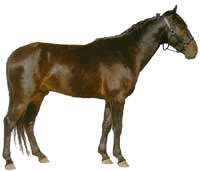 |
The Kabardin
The world's best mountain breed. Reliable & sure-footed, very economical to keep. Good for endurance rides in a rough terrain. |
The Kabardin horse, well-known since the 16th century, is one of Russia’s “extreme” breeds, that is a horse meant for living under extreme conditions. The Kabardin thrives in the most difficult mountain terrain, at high altitudes, undeterred by snow and fast rivers. Temperamentally, it is a tractable and obedient animal, being both hardy and infinitely enduring. It is safe to say that the Kabardin is the world’s best mountain breed.
| The Kabardin has been bred by the mountain tribesmen of the Northern Caucasus. Like many Russian breeds it is a product of centuries of primitive selective breeding for survival under the harshest conditions. That wondrous steed is derived from the horses of the steppe people crossed with Karabakh, Persian and Turkmenian strains. | 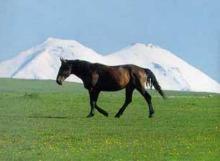 |
The Kabardin is the principal breed of the Northern Caucasus, and is widely used to improve native stock in Armenia, Azerbaijan, and Georgia. The best Kabardins are raised at the Karachai and Malka studs.
Several years ago the group of Kabardin horses bred in the Karachai republic began to be referred to as the Karachai breed. Most of the Karachai sub-breed are of the so-called massive type (see below). At the turn of the century Count Stroganov was crossing Kabardins with Arabs with satisfactory results. Now crossings with Thoroughbreds are quite popular.
Mountain home
The Kabardin is at home in the mountains and has developed characteristics that are suited to the terrain and the rigors of the climate. It is surprisingly sure-footed and rarely stumbles even when trotting or cantering downhill. The horse is impervious to cold, mountain showers and hail. It does not panic when stones begin to roll downhill. If a herdsman in riding a Kabardin, the horse will easily find the herd within 2 kilometers. Kabardins have an uncanny ability to find their way in mist and darkness.
I, Alexander Repiev, (author of this article), spent three summers as herdsman with an Anglo-Kabardin herd at over 2,500 meters in a huge picturesque gorge called Kich-Malka. The way to my hut included some narrow paths on a formidable slope. Many a time I was caught in a cloud so dense that I could only see the ears of my mount. I would then drop the rains, wrap myself in a felt coat, and... pray. My Kabardin would progress slowly and cautiously, the sound of a stone falling into the precipice from under his feet signaling that we were playing a deadly game of Russian roulette. After a long while he would stop, and I would discern, straining my sight, the wall of my hut only one meter away from my savior’s nose. That’s the horse for you!
| It would take ages to tell
stories of how Kabardins bravely cross torrential streams, how they fight
wolves, how Kabardin mares foal onto frost-bitten soil, how they would carry
you for hours on end without so much as a blade of grass to eat. They are kings
of the mountains! The higher the altitude the more apparent is the supremacy of the Kabardins over other breeds. |
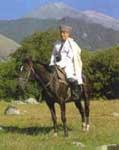 |
In the Pamir Mountains a Soviet frontier cavalry company had to climb to 4,000 meters. They rode various breeds, including Kabardins. The only breed that made it were Kabardins, other horses were dropping out at lower altitudes (the last to give up were the Dons). Helicopters could not bring hay that high, and so the Kabardins survived perfectly all right on what they could scavenge there. Back home they needed no recuperation, while other horses were allowed several days of rest.
Recently a rider on a Kabardin horse climbed the Elbrus mountain (5,642 meters), the highest peak of the Caucasus Range!
Universal mountain horse
Although the Kabardin is considered primarily to be a saddle horse, it can also be used as a pack horse, and for every sort of work in harness. Mountaineers make hay on steep slopes by hitching a couple of Kabardins into a horse mower.
I watched young boys, when their fathers were away of course, racing their Kabardins harnessed into two-wheel carriages over dangerous terrain, with teenage outriders galloping alongside, cheering wildly and making jighitovka tricks
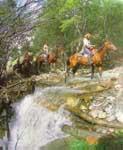 |
Conformation The conformation of the Kabardin is that of a perfect mountain horse. Some features could be called defects in a normal mount, but they serve their purpose in the mountains. The blood of the Kabardins has a heightened oxidizing capacity, their heart, lungs, tendons, ligaments, and muscles are strong and efficient. They quickly accumulate fat to keep them through worse days. They have a stable nervous system and quick reflexes, are agile and flexible. |
The body of mountain horses is dense, massive and elongated, their back is well-muscled, short and straight, and the quarters slope away from the rounded croup. The loins, though very strong, are often slightly concave.
By Western standards, the shoulders are loaded and even straight, which accounts for the high action — not a disadvantage in the mountain horse but not, of course, conducive to speed. The neck is of medium length and well muscled. It runs into somewhat flat withers.
The thick-set Kabardin has a long head to match its general proportions. The profile is Roman-nosed and the impression is that of a typical steppe horse, whose roots extend to the primitive Asian wild horse and the Tarpan. Between the ears, the poll is curiously narrow and the occipital crest is ill-defined. The ears are very sharp, alert and mobile.
The legs and feet are strong and clean. The forelegs are a good feature. They have clearly defined tendons, good joints and short, strong cannons. The bone measurement, which is 17-20 cm, is more than sufficient in relation to the built. The Kabardin’s hindlegs are often sickle-shaped, an advantage in a mountain horse.
The pasterns are properly sloped. The hoofs are unbelievably hard, so that shoeing them is often a problem — most Kabardins go unshod even on the roughest ground.
A typical feature of the Kabardin is the usually luxuriant growth of mane and tail.
The predominant colors found in the breed are dark bay, bay and black, mostly without other distinguishing marks.
Average measurements of Kabardins
| Height | Body length | Chest girth | Bone below the knee | |
| Stallions | 155 | 160 | 183.5 | 20 |
| Mares | 153 | 158 | 178 | 18.7 |
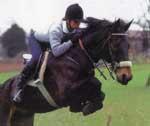 |
Performance
The Kabardin will not impress you on the racetrack, but then he is no racer on the flat. He is an intrepid stalwart of the mountains, and should be judged as such. |
Movements
The Kabardin’s action is often high. The paces are good: the walk is even and rhythmical, the trot and canter light and smooth. Some Kabardins are natural pacers.
Endurance
The Kabardin has for centuries enjoyed the reputation of an extremely undemanding and enduring horse. In the last war Kabardins were widely used as cavalry mounts, and covered the distance from Stalingrad to the Alps, having shown exceptional strength and stamina. They were especially good in the mountains.
In the winter of 1935/36 a 3,000-kilometer ride was held in the Caucasus. The time and route of the ride were extremely difficult. Among the participants there were 15 Kabardins, 8 Anglo-Kabardins, and horses of other breeds. The ride lasted 47 days, on average 64 km per day. On some days they covered 120 km. The party was accompanied by vets who were checking the horses’ pulse and breathing rates, their weight and other metabolic and mechanical parameters. The Kabardins and Anglo-Kabardins appeared to be the best all around. Many long-distance test rides were held ever since, with Kabardins invariably among the winners.
In 1946 a major test of the performance of various Russian breeds was organized in Moscow. It was a 250-km ride with the last 2 km covered in gallop. The winner was the Kabardin stallion Ali-Kadym, his time was 25 hours.
Modern types
Following the Russian Revolution, the breed was much improved. A stronger type was created for riding and agricultural work. Now Russian breeders distinguish three main types in the Kabardin breed:
Basic type.
As the name suggests this type is predominant. It is a typical mountain riding horse. Rangy and well-muscled, with a well-shaped typey head.
Oriental type.
This type shows pronounced influence of oriental breeds. The horses have very clean legs, smaller typey heads with expressive eyes, thinner elastic skins, and a temperament to match.
Massive type.
Horses of this type have longer bodies and more robust bone structures. In appearance they are closer to a carriage horse. This type is predominant among the Karachai sub-breed.
Breeding
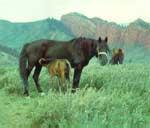 |
Kabardins are kept
in herds, and they have uncanny herd instincts. If stolen, they can escape and
find their way to their herd in several months’ time, even when feted.
Kabardin mares are very fertile and “milky,” some of them continue to produce well into their 20s. They are perfect mothers, extremely possessive and protective of their young |
Most Kabardin sires remain quite potent till 20 years and beyond, although even during the service season they receive no extra feed. In spring, breeders form so-called kosyaks, small herds of around 20. Each small herd is put in the charge of a sire, who looks after the mares, services them and protects them from other sires and wolves. The sires are so fierce that headsmen approach them with caution.
Early in May the herds begin to trek up to the alpine meadows. As the snow line recedes, they get higher and higher till they reach their destination where they spend the summer. The only extra they receive there is salt. Early in August the stallions are separated from their respective herds, and all the mares are brought together. In September, with the first snow, the herds begin to migrate back home.
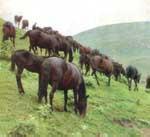 |
The horses spend winters
out or in enclosures, they are grazed and receive some hay. The weaning occurs
in November. The yearlings are split according to sex and are grazed and trained separately. |
Anglo-Kabardin
The Anglo-Kabardin was created by crossing Kabardins and Thoroughbreds. Anglo-Kabardins are bigger and rangier. They are nearer to the Thoroughbred in conformation: they have a longer neck, a shorter back, and better legs. They are faster on the track, but they are more demanding and not so suited to herd keeping in the mountains as the Kabardins. To be sure, their performance in the mountains depends on the amount of Thoroughbred blood in them. Overall, they are good for up to 1800 meters. Above that altitude, especially for “up-and-down” everyday work, only pure-bred Kabardins are recommended.
Because of their sure-footedness Kabardins and Anglo-Kabardins make perfect mounts for circus jighitovka riders, especially for two-man tricks
 |
All the information and photographs for this section were kindly provided by Troika, the ultimate Russian horse resource online. For further information on Russian horses and horsemanship please click here |